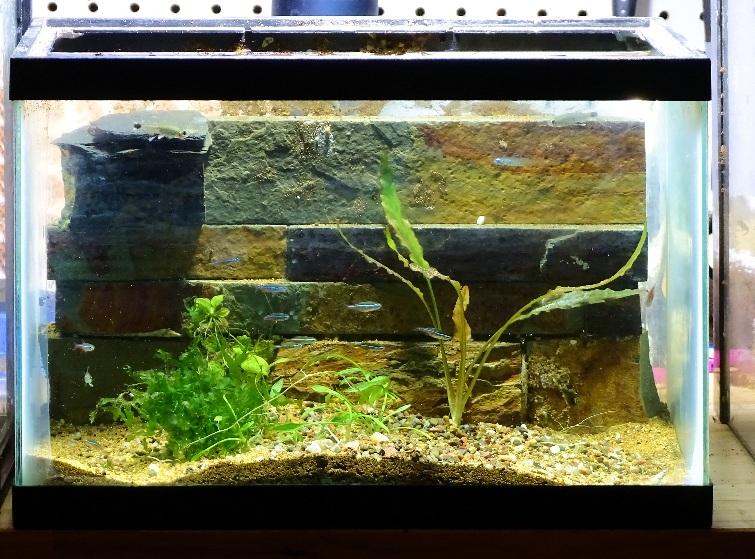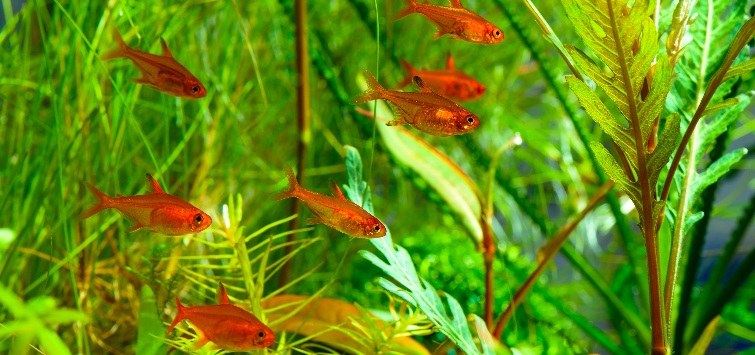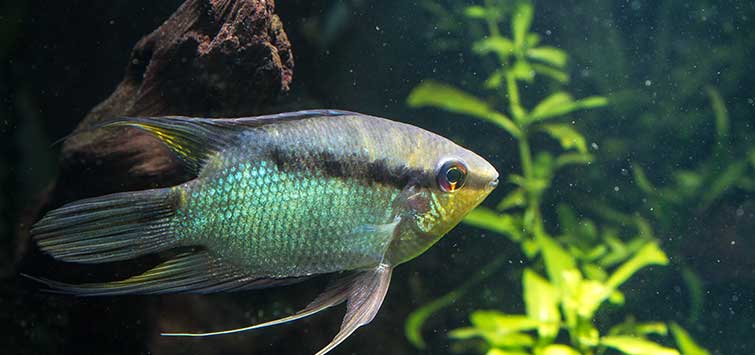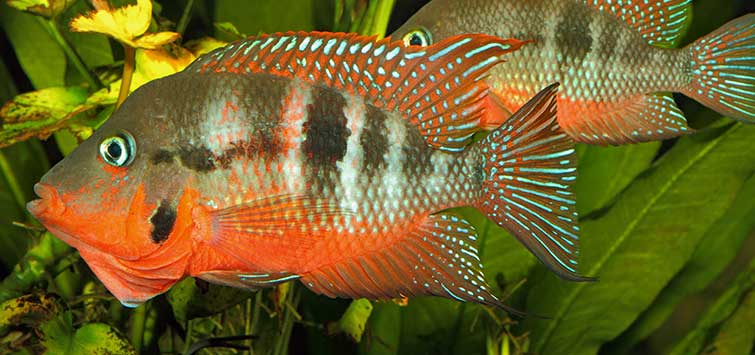Keeping & Breeding Clown Killifish
Joshua Wiegert
The clown killifish, known scientifically as Epiplatys annulatus, is a tiny member of the group of fishes known as killifish, though killies are small fish anyway. The clown killifish, fully grown, will get to just about 1½ inches in length (3.5 cm). They’re not at all large.
Despite the slightly alarming “kill” in their names, most killies are peaceful, placid fish that make the neon tetra look like the neon piranha. “Kill” actually comes from the Dutch word for a small creek, which they call a kill. If you’ve travelled extensively in parts of New England that were settled by the Dutch, you may have seen the term as you pass over streams on roadways—it’s particularly prevalent in New York’s Hudson Valley.
As may be implied from naming the group “small-stream fish,” killies are often typically found in weed-choked, slow-flowing bodies of water. Another group of killies is found in temporary pools of water, which often go entirely dry. These killies, known as annual killifish, have a really bizarre lifecycle in which they lay eggs that settle into the mud and muck at the bottom of the pool, dry out, and remain there until the rains return to fill the pool again. Annual killies hatch, grow, mature, and breed all in a few months.
While annual killies are the best-known members of the killifish group, the vast majority of killifish are not annuals; they live like most any other fish. The clown killifish is a member of this larger group of nonannual killifish. (I’ve always joked that we should call these perennial killifish, but no one ever listens to me.) The scientific name “annulatus” would seem to imply that they should be annual, but this is not the case. Annulatus means “ringed” and refers to the pattern of black bands that encircle the fish. The similarity to the word “annual” is coincidental.
As well as this Latin name, the clown killifish has a bunch of other fun English names. They’re also known as rocket killifish—their bright orange-and-yellow tail is reminiscent of the exhaust from a rocket. They also have a far more boring name, “banded killifish,” or “banded panchax,” with panchax being a formerly used name for killifish.
A New Setup

So, in the previous issue, we set these guys up in the (in)famous Utz jar, a favorite choice for killifish breeders and keepers. Unfortunately—and there’s no polite way to say this—those jars make fairly ugly fish tanks. The Utz jar is really great if you only want to keep these fish for breeding, but it is not something you want to use as a permanent home for any fish. Thus, I moved the clown killifish to a slightly better home.
They’re really small, and they don’t need a lot of swimming room. I chose to put them in a standard 5½ -gallon (21-liter) aquarium, but they’ll do well in just about any tank you can pick. I’ve seen them in full-sized tanks as part of a small fish community, and they do fine, and if I can keep them in an Utz jar, I guarantee you can keep them in any tiny desktop aquarium.
However, the one thing they do desperately need is a lid! While the name “rocket” is mostly inspired by their pattern, they can also turn themselves into tiny rockets and make amazing leaps. I had the Utz jar filled only about 2/3 of the way up (which won’t help it win any beauty prizes). This was to theoretically prevent them making like tiny rockets, but even with that much space, I still had one achieve orbit. Ironically, my Utz container came with a perfectly good aquarium lid, and, in hindsight, I probably should have used it.
As mentioned, killifish are by and large residents of weed-choked, slow-flowing areas. That’s my favorite kind of environment to emulate, because that’s just an overgrown planted tank. Sure, I suppose you can keep them in a pretty aquascaped tank, but me? I’m typically stuffing every kind of plant I can into my planted tanks, to the point where when I trim them, the water level drops! This is an ideal environment for these guys.
Water quality is important for the clown killifish. They don’t like a lot of flow, so a sponge filter is a good choice, but you can even go filterless, particularly in a heavily planted tank. Just keep the feedings light. A small outside power filter will also work, but the large gap in the lid where it returns water may just provide an avenue for the clown killies to achieve escape velocity. I have kept bettas in such tanks by using a piece of plastic screen (the mesh for needlepoint works well) and eggcrate. Just be absolutely certain you’re cleaning this regularly enough to discourage algae growth or it’ll block the return flow.
Most clown killies are from captive-raised strains that are generations removed from their native waters in West Africa. They’re fairly forgiving about water chemistry, but they’ll really do best in soft, acidic water. Having some driftwood or a handful of oak and magnolia leaves in the tank to add some tannins really helps them, and I think their color just pops in a tea-colored tank.
<center><strong>Enjoying TFH Magazine? Subscribe Today!</strong></center>
Clown Killifish Tankmates

Other tiny tetras will also mix well. One of my favorites is the ember tetra (Hyphessobrycon amandae). You can also try other species of small killifish; the various lampeyes immediately spring to mind. Shrimp work well as clown killifish tankmates, too. And, if you’re not dead set on breeding them, some larger fish will also be okay, as long as they can’t eat the adult clown killies. The small scarlet badis (Dario dario) is a good choice.
Feeding these guys can be a little bit of a challenge. Small fish have small mouths, as well as small stomachs. You’ll want to try a very fine pellet or flake food, or just grind your flakes well, and be careful not to overfeed. With low-flow filtration, overfeeding can be problematic, quickly fouling the water.
Breeding Clown Killifish
Male clown killifish are about 50 percent larger than the females, which isn’t saying much. Males are also more colorful, especially in the finnage. Females usually have plain or clear fins. In mature fish, the males get extended rays in these fins, too.
I’ve noticed that some females have color to their fins, though not as intense and bright as males, yet older literature insists that they’re always clear or yellowish. I wonder if this isn’t a case of unintentional artificial selection, where we’ve been accidentally breeding this trait into the captive species. I find this particularly likely, as many batches of fish in retailers’ tanks look to be almost entirely male. It’s likely the less-attractive females are culled by sellers and only colorful ones sneak through. Either that, or the old-timers were wrong (perish the thought!).
If you have males and females in a tank, they’re gonna do what they’re gonna do. Clown killies will spawn almost continuously when in good condition. Little tiny eggs are going to be deposited in tangles of plants. Some aquarists use spawning mops for breeding clown killifish, but I’m happy to spawn them in plants.
I suppose you can put Java moss in the tank and let them spawn in that, too. The eggs are ridiculously small, and you would certainly be forgiven for not noticing them. You will, however, soon see tiny fry darting around the surface of the water.
The bad news is that you’re probably going to want to feed them microworms, which you’ll need to culture and get going before the eggs hatch. In a well-planted tank, they’ll probably find enough microfoods to survive, but growth will be slow, and survivorship low. However, it’ll be enough that you’ll continually replace any fish you’ll lose to age and likely grow your population. But, if you want to really rear the fry, you’re going to need some microworms, or other very small live foods.
You can also try artificially rearing the fry. This is where a spawning mop comes in handy. Condition your sexes separately, put them in a tank with the mop and let them spawn for a day or two. Return the breeders to their tank, and let the eggs incubate for about 10 days. You’ll get a lot more fry this way.
For their first three or four days, they’re going to need infusoria. You can culture this separately, or simply add a small bit of oak leaf and a handful of “pest” snails, and the leaf matter will be broken down into bacteria that the fry can eat.
Help them out and lower the water level, though be cautious to maintain water quality and temperature. Within a week or so, they can graduate to microworms, baby brine shrimp, or even finely ground flakes. Keep in mind that this stuff will foul the water if uneaten and plan accordingly. Personally, I find this to be a lot of work for a fish that’ll breed on its own in a well-planted tank.
Pretty Little Fish
The bright colors of the clown killifish are hard to match. They’re incredibly gorgeous, thrive in the smallest of tanks, and breed easily. I don’t understand why this tiny little gem isn’t far more popular. They’ve really got it all. And they definitely are worthy of a nicer-looking tank than a snack jar—just be sure to keep a tight-fitting lid on it!

.png?h=595&iar=0&w=2781&hash=5FD5E69473BCC22199FBFA2FB71B6033)

.png?h=250&iar=0&w=970&hash=CB4184B478B298E60EE37B6A8FADE4DE)

